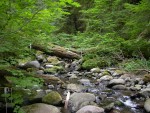A recent study analyzing long-term trends in stream nitrogen from four Long Term Ecological Research (LTER) sites has found that nitrates in U.S. streams have declined in certain regions and increased in others.
The study led by Alba Argerich and Sherri Johnson from H.J. Andrews Forest LTER, whose results were recently published in Environmental Research Letters (doi:10.1088/1748-9326/8/1/014039) and featured in a video abstract, evaluates time series of stream inorganic nitrogen concentrations from 22 forested reference catchments in seven experimental forests and LTER sites. These sites span a wide range of climatic, hydrologic and vegetation conditions across the U.S. The study found that even these near-pristine forested streams are showing certain trends in nitrogen concentrations: stream nitrate has declined in the Pacific Northwest, in the Northeast, and in Puerto Rico, but has increased in the Mountain West and the South.
Other key findings are that the direction of trends in certain watersheds used as reference vary with the length of record used, and that adjacent watersheds within a site do not necessarily show similar responses. The study is part of a larger effort to understand the effects of disturbances on water quality and to inform the criteria for developing nutrient standards using the natural variability of stream chemistry concentrations. An additional feature of this project is the development of a publicly accessible stream chemistry database (StreamChemDB) to store and facilitate sharing of long-term chemistry data.
Video: http://bcove.me/gh3d2bkj
Group website: Stream Chemistry Synthesis Project http://web.fsl.orst.edu/streamchem/

 Enlarge this image
Enlarge this image
